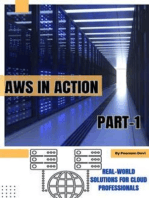AWS Module 3 Notes
Uploaded by
Sendo SegundoAWS Module 3 Notes
Uploaded by
Sendo Segundo# Module 3 - AWS Global Infrastructure Overview
[Slides](http://d8rg5deuq9171.cloudfront.net/handouts/Slides/
AcademyCloudFoundations_Module_03.pdf)
## Objectives / Topics
- Identify the difference between AWS Regions, Availability Zones, and edge
locations
- Identify AWS service and service categories
<br/>
## Labs / Activities
- [Knowledge Check](https://www.aws.training/Details/Curriculum?transcriptid=-
NscDQNnt0KwQEi-zYfB8Q2&id=43078#modules)
- [Lab: AWS Management Console (Use
Sandbox)](https://labs.vocareum.com/main/main.php) -- [Labs
Instructions](http://d8rg5deuq9171.cloudfront.net/handouts/Vocareum%20scripts/Lab
%20X%20-%20Sandbox.pdf)
- [AWS Global Infrastructure
Activity](http://d8rg5deuq9171.cloudfront.net/handouts/Activities/Module
%203%20Activity%20-%20AWS%20Global%20Infrastructure.pdf)
<br/>
## Section 1: AWS Global Infrastructure
The [AWS Global Infrastructure](https://infrastructure.aws/) is designed and built
to deliver a flexible, reliable, scalable, and secure cloud computing environment
with high-quality global network performance.
### **AWS Regions**
An AWS Region is a geographical area.
- Data replication across Regions is controlled by you.
- Communication between Regions uses AWS backbone network infrastructure.
- Each Region provides full redundancy and connectivity to the network.
- A Region typically consists of two or more Availability Zones
When selecting a region consider the following:
- Laws - Data governance and legal requirements
- Proximity - Select regions close to your customers for reduced latency
- Availability - Some services are region locked
- Cost - Cost varies by region
Each Availability Zone is a fully isolated partition of the AWS infrastructure.
There are currently 69 Availability Zones worldwide.
- Availability Zones consist of discrete data centers
- They are interconnected with other Availability Zones by using high-speed private
networking
- They are designed for fault isolation
- You choose your Availability Zones but AWS recommends replicating data and
resources across Availability Zones for resiliency.
### **AWS Data Centers**
- AWS data centers are designed for security. Each data center has redundant power,
networking, and connectivity, and is housed in a separate facility.
- Data centers are where the data resides and data processing occurs. A data center
typically has 50,000 to 80,000 physical servers
AWS provides a global network of 187 Points of Presence locations:
- Consists of 176 edge locations - where end users access services located at AWS
- 11 Regional edge caches - cache copies of your infrequent content close to your
users
- Used with **Amazon CloudFront** - a fast content delivery network (CDN) service
that securely delivers data, videos, applications, and APIs to customers globally
with low latency, high transfer speeds, all within a developer-friendly
environment.
AWS Infrastructure Features:
1. Elasticity and scalability - dynamically adapts to capacity and growth needs
2. Fault-tolerance - Continues operating properly in the presence of a failure due
to built-in redundancy of components
3. High availability - High operational performance with minimized downtime and no
human intervention
<br/>
## Section 2: AWS Services and Service Category Overview
### **Foundation Services**
- Compute
- Networking
- Storage
### **Service Categories**
23 different product or service categories, and each category consists of one or
more services. The course covers the most common categories and the ones likely to
be on the foundations exam.
#### AWS Storage Services
- [Amazon Simple Storage Services (S3)](https://aws.amazon.com/s3/) - Object
storage service that offers industry-leading scalability, data availability,
security, and performance.
- [Amazon Elastic Block Storage (EBS)](https://aws.amazon.com/ebs) - An easy to
use, high performance block storage service designed for use with Amazon Elastic
Compute Cloud (EC2) for both throughput and transaction intensive workloads at any
scale.
- [Amazon Elastic File System (EFS)](https://aws.amazon.com/efs/) - A simple,
scalable, fully managed elastic NFS file system for use with AWS Cloud services and
on-premises resources.
- [Amazon Simple Storage Service Glacier](https://aws.amazon.com/glacier/) - A
secure, durable, and extremely low-cost Amazon S3 cloud storage classes for data
archiving and long-term backup.
#### AWS Compute Services
- [Amazon EC2](https://aws.amazon.com/ec2/) - A web service that provides secure,
resizable compute capacity in the cloud.
- [Amazon EC2 Auto Scaling](https://aws.amazon.com/ec2/autoscaling/) - Helps to
maintain application availability and allows you to automatically add or remove EC2
instances according to conditions you define.
- [Amazon Elastic Container Services (ECS)](https://aws.amazon.com/ecs/) - A fully
managed container orchestration service.
- [Amazon EC2 Container Registry (ECR)](https://aws.amazon.com/ecr/) - A fully-
managed Docker container registry that makes it easy for developers to store,
manage, and deploy Docker container images.
- [AWS Elastic Beanstalk](https://aws.amazon.com/elasticbeanstalk/) - An easy-to-
use service for deploying and scaling web applications and services developed with
Java, .NET, PHP, Node.js, Python, Ruby, Go, and Docker on familiar servers such as
Apache, Nginx, Passenger, and IIS.
- [AWS Lambda](https://aws.amazon.com/lambda/) - Lets you run code without
provisioning or managing servers.
- [Amazon Elastic Kubernetes Services (EKS)](https://aws.amazon.com/eks/) - A fully
managed [Kubernetes](https://en.wikipedia.org/wiki/Kubernetes) service.
- [AWS Fargate](https://aws.amazon.com/fargate/) - A serverless compute engine for
containers that works with both Amazon Elastic Container Service (ECS) and Amazon
Elastic Kubernetes Service (EKS).
#### AWS Database Services
- [Amazon Relational Database Service (RDS)](https://aws.amazon.com/rds/) - Makes
it easy to set up, operate, and scale a relational database in the cloud.
- [Amazon Aurora](https://aws.amazon.com/rds/aurora/) - A MySQL and PostgreSQL
compatible relational database built for the cloud, that combines the performance
and availability of traditional enterprise databases with the simplicity and cost-
effectiveness of open source databases.
- [Amazon Redshift](https://aws.amazon.com/redshift/) - A fully managed, petabyte-
scale data warehouse service in the cloud.
- [Amazon DynamoDB](https://aws.amazon.com/dynamodb/) - A key value and document
database that delivers single-digit millisecond performance at any scale.
#### Networking and Content Delivery Services
- [Amazon VPC](https://aws.amazon.com/vpc/) - Lets you provision a logically
isolated section of the AWS Cloud where you can launch AWS resources in a virtual
network that you define.
- [Elastic Load Balancing](https://aws.amazon.com/elasticloadbalancing/) -
Automatically distributes incoming application traffic across multiple targets,
such as Amazon EC2 instances, containers, IP addresses, and Lambda functions.
- [Amazon CloudFront](https://aws.amazon.com/cloudfront/) - A fast content delivery
network (CDN) service that securely delivers data, videos, applications, and APIs
to customers globally with low latency, high transfer speeds, all within a
developer-friendly environment.
- [AWS Transit Gateway](https://aws.amazon.com/transit-gateway/) - A service that
enables customers to connect their Amazon Virtual Private Clouds (VPCs) and their
on-premises networks to a single gateway.
- [Amazon Route 53](https://aws.amazon.com/route53/) - A highly available and
scalable cloud Domain Name System (DNS) web service.
- [AWS Direct Connect](https://aws.amazon.com/directconnect/) - A cloud service
solution that makes it easy to establish a dedicated network connection from your
premises to AWS.
- [AWS VPN](https://aws.amazon.com/vpn/) - Lets you establish a secure and private
encrypted tunnel from your network or device to the AWS global network.
#### Security, Identity, and Compliance Services
- [AWS Identity and Access Management (IAM)](https://aws.amazon.com/iam/) -
Enables you to manage access to AWS services and resources securely. You can create
and manage AWS users and groups, and use permissions to allow and deny their access
to AWS resources. IAM is a feature of your AWS account offered at no additional
charge.
- [AWS Organizations](https://aws.amazon.com/organizations/) - helps you centrally
govern your environment as you grow and scale your workloads on AWS.
- [Amazon Cognito](https://aws.amazon.com/cognito/) - Lets you add user sign-up,
sign-in, and access control to your web and mobile apps quickly and easily.
- [AWS Artifact](https://aws.amazon.com/artifact/) - A central resource for
compliance related information that matters to you.
- [AWS Key Management Service (KMS)](https://aws.amazon.com/kms/) - Makes it easy
for you to create and manage cryptographic keys and control their use across a wide
range of AWS services and in your applications.
- [AWS Shield](https://aws.amazon.com/shield/) - A managed Distributed Denial of
Service (DDoS) protection service that safeguards applications running on AWS.
#### Cost Management Services
- [AWS Cost and Usage Report](https://aws.amazon.com/aws-cost-management/aws-cost-
and-usage-reporting/) - contains the most comprehensive set of AWS cost and usage
data available, including additional metadata about AWS services, pricing, and
reservations (e.g., Amazon EC2 Reserved Instances (RIs)).
- [AWS Budgets](https://aws.amazon.com/aws-cost-management/aws-budgets/) - gives
you the ability to set custom budgets that alert you when your costs or usage
exceed (or are forecasted to exceed) your budgeted amount.
- [AWS Cost Explorer](https://aws.amazon.com/aws-cost-management/aws-cost-
explorer/) - an easy-to-use interface that lets you visualize, understand, and
manage your AWS costs and usage over time.
#### AWS Management and Governance Services
- [AWS Management Console](https://aws.amazon.com/console/) - A secure, easy-to-
access, web-based portal for AWS.
- [AWS Config](https://aws.amazon.com/config/) - A service that enables you to
assess, audit, and evaluate the configurations of your AWS resources.
- [Amazon CloudWatch](https://aws.amazon.com/cloudwatch/) - A monitoring and
observability service that provides you with data and actionable insights to
monitor your applications, respond to system-wide performance changes, optimize
resource utilization, and get a unified view of operational health. You can use it
to detect anomalous behavior in your environments, set alarms, visualize logs and
metrics side by side, take automated actions, troubleshoot issues, and discover
insights.
- [AWS Auto Scaling](https://aws.amazon.com/autoscaling/) - monitors your
applications and automatically adjusts capacity to maintain steady, predictable
performance at the lowest possible cost.
- [AWS Command Line Interface (CLI)](https://aws.amazon.com/cli/) - a unified tool
to manage your AWS services. With just one tool to download and configure, you can
control multiple AWS services from the command line and automate them through
scripts.
- [AWS Trusted Advisor](https://aws.amazon.com/premiumsupport/technology/trusted-
advisor/) - An online tool that provides you real time guidance to help you
provision your resources following AWS best practices.
- [AWS Well-Architected Tool](https://aws.amazon.com/well-architected-tool/) -
Helps you review the state of your workloads and compares them to the latest AWS
architectural best practices.
- [AWS CloudTrail](https://aws.amazon.com/cloudtrail/) - A service that enables
governance, compliance, operational auditing, and risk auditing of your AWS
account.
<br/>
---
<br/>
[Knowledge Check](https://www.aws.training/Details/Curriculum?transcriptid=-
NscDQNnt0KwQEi-zYfB8Q2&id=43078#modules)
[Lab: AWS Management Console (Use
Sandbox)](https://labs.vocareum.com/main/main.php) -- [Labs
Instructions](http://d8rg5deuq9171.cloudfront.net/handouts/Vocareum%20scripts/Lab
%20X%20-%20Sandbox.pdf)
[AWS Global Infrastructure
Activity](http://d8rg5deuq9171.cloudfront.net/handouts/Activities/Module
%203%20Activity%20-%20AWS%20Global%20Infrastructure.pdf)
You might also like
- AWS Associate Solutions Architect Study - ACloud - GuruNo ratings yetAWS Associate Solutions Architect Study - ACloud - Guru70 pages
- Manual of Infection Prevention and Control (PDFDrive)100% (2)Manual of Infection Prevention and Control (PDFDrive)399 pages
- What Is AWS? Amazon Cloud (Web) Services TutorialNo ratings yetWhat Is AWS? Amazon Cloud (Web) Services Tutorial10 pages
- What Is AWS? Amazon Cloud Services TutorialNo ratings yetWhat Is AWS? Amazon Cloud Services Tutorial43 pages
- What Is AWS? Amazon Cloud Services TutorialNo ratings yetWhat Is AWS? Amazon Cloud Services Tutorial43 pages
- Aws Alfresco Enterprise Reference ArchitectureNo ratings yetAws Alfresco Enterprise Reference Architecture13 pages
- What Is Aws?: Saas (Software As A Service)No ratings yetWhat Is Aws?: Saas (Software As A Service)16 pages
- Unit 6- Cloud Platforms and ApplicationsNo ratings yetUnit 6- Cloud Platforms and Applications32 pages
- Day2-Service Models, Deployment Models, AWS OverviewNo ratings yetDay2-Service Models, Deployment Models, AWS Overview2 pages
- Data Lake Foundation WTH Zeppelin and Amazon Rds On The Aws CloudNo ratings yetData Lake Foundation WTH Zeppelin and Amazon Rds On The Aws Cloud23 pages
- AWS in ACTION Part -1: Real-world Solutions for Cloud ProfessionalsFrom EverandAWS in ACTION Part -1: Real-world Solutions for Cloud ProfessionalsNo ratings yet
- The Effectiveness of Banana (Musa Balbasiana) Peelings and Mango (Mangifera Indica) Peelings As A Bioethanol Fuel100% (2)The Effectiveness of Banana (Musa Balbasiana) Peelings and Mango (Mangifera Indica) Peelings As A Bioethanol Fuel18 pages
- Antidesma Bunius: Physicochemical Properties of Bignay ( (L.) Spreng.) Wine at Different Stages of ProcessingNo ratings yetAntidesma Bunius: Physicochemical Properties of Bignay ( (L.) Spreng.) Wine at Different Stages of Processing8 pages
- Free Access to Test Bank for Guide to Firewalls and VPNs, 3rd Edition Chapter Answers100% (6)Free Access to Test Bank for Guide to Firewalls and VPNs, 3rd Edition Chapter Answers30 pages
- How To Read P&Ids: Dave Harrold, Senior Editor Control Engineering August 1, 2000No ratings yetHow To Read P&Ids: Dave Harrold, Senior Editor Control Engineering August 1, 20006 pages
- Practical Work in Geography Ch-6 Gis NewNo ratings yetPractical Work in Geography Ch-6 Gis New44 pages
- Tertiary Tectonic of Barito Basin, South East Kalimantan, and Implication For Petroleum SystemNo ratings yetTertiary Tectonic of Barito Basin, South East Kalimantan, and Implication For Petroleum System16 pages
- Dba 302 Accounting Rate of Return, NPV and Irr PresentationsNo ratings yetDba 302 Accounting Rate of Return, NPV and Irr Presentations12 pages
- Letter From Department of State General Counsel Brad McvayNo ratings yetLetter From Department of State General Counsel Brad Mcvay2 pages
- Main Relief Valve and Waste Cone - : Submittal DrawingNo ratings yetMain Relief Valve and Waste Cone - : Submittal Drawing2 pages
- Practice of Urban Aerial Ropeways: Work Report No.1No ratings yetPractice of Urban Aerial Ropeways: Work Report No.179 pages
- Fake Account Detection Using Machine Learning Techniques100% (1)Fake Account Detection Using Machine Learning Techniques7 pages
- Assignment On - KANBAN, INCREASING OVERALL EQUIPMENT EFFICTIVENESS OF PLASMA CUTTING MACHINE AND STUDY OF WELDING PROCESSES.No ratings yetAssignment On - KANBAN, INCREASING OVERALL EQUIPMENT EFFICTIVENESS OF PLASMA CUTTING MACHINE AND STUDY OF WELDING PROCESSES.102 pages
- Understanding Strategic Management Cap. 3 Anthony E. Henry Oxford Prez TOMA100% (1)Understanding Strategic Management Cap. 3 Anthony E. Henry Oxford Prez TOMA20 pages
- AWS Associate Solutions Architect Study - ACloud - GuruAWS Associate Solutions Architect Study - ACloud - Guru
- Manual of Infection Prevention and Control (PDFDrive)Manual of Infection Prevention and Control (PDFDrive)
- Day2-Service Models, Deployment Models, AWS OverviewDay2-Service Models, Deployment Models, AWS Overview
- Data Lake Foundation WTH Zeppelin and Amazon Rds On The Aws CloudData Lake Foundation WTH Zeppelin and Amazon Rds On The Aws Cloud
- AWS in ACTION Part -1: Real-world Solutions for Cloud ProfessionalsFrom EverandAWS in ACTION Part -1: Real-world Solutions for Cloud Professionals
- AWS Certified Solutions Architect - Associate Exam Prep kitFrom EverandAWS Certified Solutions Architect - Associate Exam Prep kit
- AWS SysOps Administrator Associate: From basic to advancedFrom EverandAWS SysOps Administrator Associate: From basic to advanced
- AWS Associate Architect: From basic to advancedFrom EverandAWS Associate Architect: From basic to advanced
- The Effectiveness of Banana (Musa Balbasiana) Peelings and Mango (Mangifera Indica) Peelings As A Bioethanol FuelThe Effectiveness of Banana (Musa Balbasiana) Peelings and Mango (Mangifera Indica) Peelings As A Bioethanol Fuel
- Antidesma Bunius: Physicochemical Properties of Bignay ( (L.) Spreng.) Wine at Different Stages of ProcessingAntidesma Bunius: Physicochemical Properties of Bignay ( (L.) Spreng.) Wine at Different Stages of Processing
- Free Access to Test Bank for Guide to Firewalls and VPNs, 3rd Edition Chapter AnswersFree Access to Test Bank for Guide to Firewalls and VPNs, 3rd Edition Chapter Answers
- How To Read P&Ids: Dave Harrold, Senior Editor Control Engineering August 1, 2000How To Read P&Ids: Dave Harrold, Senior Editor Control Engineering August 1, 2000
- Tertiary Tectonic of Barito Basin, South East Kalimantan, and Implication For Petroleum SystemTertiary Tectonic of Barito Basin, South East Kalimantan, and Implication For Petroleum System
- Dba 302 Accounting Rate of Return, NPV and Irr PresentationsDba 302 Accounting Rate of Return, NPV and Irr Presentations
- Letter From Department of State General Counsel Brad McvayLetter From Department of State General Counsel Brad Mcvay
- Main Relief Valve and Waste Cone - : Submittal DrawingMain Relief Valve and Waste Cone - : Submittal Drawing
- Practice of Urban Aerial Ropeways: Work Report No.1Practice of Urban Aerial Ropeways: Work Report No.1
- Fake Account Detection Using Machine Learning TechniquesFake Account Detection Using Machine Learning Techniques
- Assignment On - KANBAN, INCREASING OVERALL EQUIPMENT EFFICTIVENESS OF PLASMA CUTTING MACHINE AND STUDY OF WELDING PROCESSES.Assignment On - KANBAN, INCREASING OVERALL EQUIPMENT EFFICTIVENESS OF PLASMA CUTTING MACHINE AND STUDY OF WELDING PROCESSES.
- Understanding Strategic Management Cap. 3 Anthony E. Henry Oxford Prez TOMAUnderstanding Strategic Management Cap. 3 Anthony E. Henry Oxford Prez TOMA






























































































